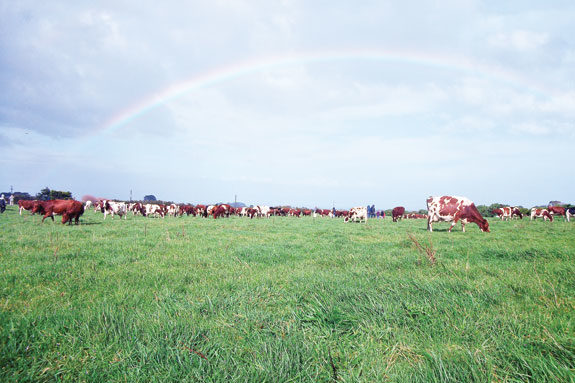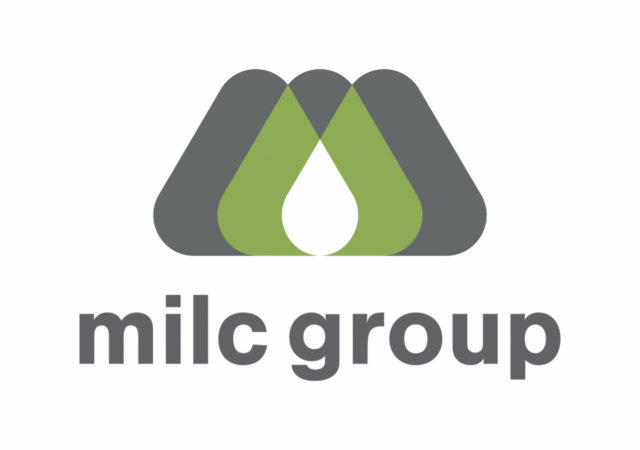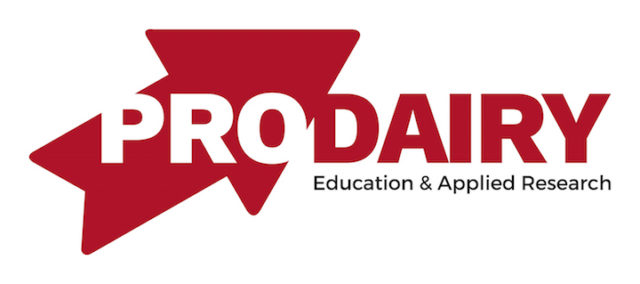I was riding on the back of a four-wheeler with the perfect cone-shaped volcanic Mt. Taranaki in the backdrop. A Kiwi (New Zealander) farmer drove through his lush green pastures, and I listened as he describes each of his Ayrshire dairy cows to me. This is one of many picturesque memories of my journey to learn more about the New Zealand dairy industry this past spring.
New Zealand is an island country of 4.4 million people, which is a little over half the population of New York City (8.1 million). It is located in the southwestern Pacific Ocean and consists of two main islands – the North and South Island.
I have wanted to travel to New Zealand ever since high school because of the scope of their dairy industry. This goal became a reality when I had the privilege to study abroad at Lincoln University , an agricultural school on New Zealand’s South Island.

Learning the lingo
Going from a dairy farm in Pennsylvania to living in New Zealand for four months took some time to get used to the differences within the two dairy industries.New Zealand is predominantly all pasture- and seasonal-based production.
This leads to designated calving, breeding and drying-off periods throughout the year.
It was confusing for me that their seasons are opposite of the U.S. and as much of the rest of the world, their units of measurements are different.
I heard discussions of kilograms of milk solids per cow, stocking rates per hectare, pre-grazing and post-grazing pasture mass, six-week-in-calf rates and empty rates.
The stocking rate of cows per hectare is a farmer’s balancing challenge for milk production, maintenance of pasture quality and environmental impacts. In reference to reproduction, the six-week-in-calf rate is the percent of animals bred in the first six weeks of the breeding season and the empty rate is the amount of animals that did not conceive, the equivalent of open cows. After grasping some of the different lingo, I was able to further explore their industry.
Currently, the average herd size is 386 cows, more than twice the U.S. average herd size of 179 cows. However, similar to the U.S, there is a trend of herds getting larger. This is especially true on the South Island, where there are larger farms and ones that are being converted from grazing sheep to dairy cows.
New Zealand plays a key role on the global dairy market. It exports 95 percent of their milk production, making them the world’s largest exporter of dairy products. Although it is a smaller country, New Zealand produces 4 percent of the world’s milk.
Because of their exporting mentality, New Zealand dairy farmers put more emphasis on producing high milk solids because most of the milk is converted to milk powder for export. There has been an increasing trend in the average milk solids per cow, which is currently 334 kg (736 pounds) per lactation, according to New Zealand Dairy Statistics 2010-2011. The average liters of milk produced per cow in a season is 3,829 (about 1,011 gallons).

Main industry issues
Three current issues in New Zealand’s dairy industry that are commonly discussed are inductions of calving, the public’s perception of “dirty dairying” and sustainability of housing versus pasture-based systems.
I did not realize calving inductions could be used in seasonal systems before going to New Zealand.
Farmers can sometimes induce cows to calve to match pasture growth. This results in many stillborn or weak calves.
In the current season farmers are only allowed to induce up to 4 percent of the herd. Overall, inductions are becoming less common and are being phased out.
New Zealand works to maintain a clean and green image. They have some of the safest drinking water in the world. I was amazed that the dairy industry still faces criticism from the public through activist groups similar to those in the U.S. Even though the cows are not confined to barns, the public is concerned about nitrate leaching and dairy cows contaminating the island’s pristine water.
The issue I chose to explore in-depth in my academic studies was the sustainability of pasture-based compared to indoor housing systems. Factors include profitability, environmental effects and animal well-being.
During the winter, wintering barns or standoff pads are more relevant in the Southland and Otago areas because of higher moisture and colder temperatures. In addition, economics play a significant role in this decision-making. Housed systems are not common but will likely be seen more in the future, especially on the southern part of the South Island.

Differences in management
One of the big things that surprised me about New Zealand dairy operations was milking preparation procedures.
I realized on the first farm I visited that they do not pre-dip, strip or dry off teats before milking the animal. Workers just put the units on. If the cow is really dirty, they would wipe her off.
I later found out from talking to other farmers and in my dairy science class that this is a common practice.
My lecturer said that New Zealand’s research has found that in the grazing system the pre-dipping procedures do not make much of a difference.
I found this hard to believe, and it is interesting that it works for them. Post-dipping is still included in their milking protocol, and all commercial milk is pasteurized. New Zealanders are not allowed to use any rBST.
There are many additional contrasting points with the New Zealand and U.S. dairy industry. In general, the animals are shorter with more width, depth of fore and rear rib with sound feet and legs to fit their grazing systems. There are more crossbreeds, called Kiwi-crosses, than I realized. Nearly 39 percent of the 4.5 million cows in New Zealand are Holstein-Friesian and Jersey crossbreeds, while 40 percent are purebred Holstein-Friesian.
In reflecting on my time in the beautiful country of New Zealand, I realized my foreign-exchange experience has given me a broader perspective on the global agricultural industry. It showed me the value of looking at situations from alternative points of view. There are not one-size-fits-all solutions in the global dairy industry. PD
Progressive Dairyman invited Penn State student Hannah Wentworth to share her regular blog posts about her study abroad trip to New Zealand in our Extra e-newsletters beginning this past spring.
PHOTOS
PHOTO 1: Ayrshires grazing ubder a rainbow in New Zealand.
PHOTO 2: At an Ayrshire Farm in the Taranaki area.
PHOTO 3: Going from a dairy farm in Pennsylvania to living in New Zealand for four months, it took some time to get used to the differences within the two dairy industries.
PHOTO 4 : New Zealand is predominantly all pasture-based and seasonal production. Photos courtesy of Hannah Wentworth.







